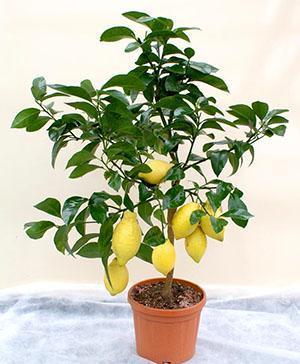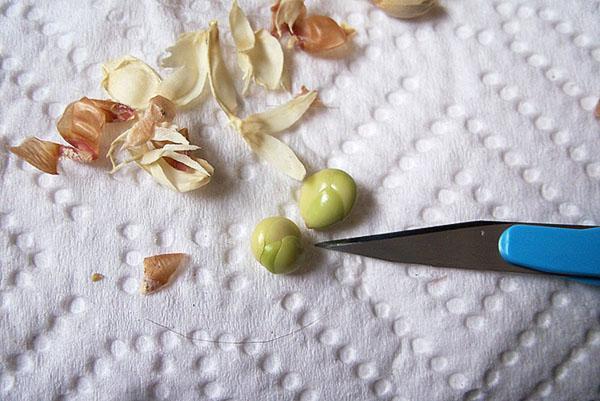How to grow a lemon from a seed at home
 Many types of citrus fruits grow well at home. But how to grow a lemon from a seed, which would not only decorate the room with leathery dark green foliage, but also bear fruit?
Many types of citrus fruits grow well at home. But how to grow a lemon from a seed, which would not only decorate the room with leathery dark green foliage, but also bear fruit?
It is the lack of ovaries on grown plants that often disappoints home citrus growers. Indeed, in the best case, from the moment of planting to the flowering of an indoor lemon, it takes from 4 to 7 years. And yet, getting a lemon from a seed is an exciting and not a futile exercise. A strong tree can be used as a rootstock by grafting a stalk of a cultivated specimen on it, or push it to fruiting with competent care and crown formation.
Preparing seeds for growing lemon
If you are going to grow a lemon from a seed at home, you need to be patient and have some knowledge.
The main mistake of indoor plant lovers who have failed in growing lemon or other citrus fruits is that they used seeds for sowing that had long been extracted from the fruit and had time to dry out.
It is much more correct to extract seeds from ripe fresh lemons, rinse them with warm water and embed them in the substrate immediately, without drying. This will multiply the number of seedlings.
Experienced citrus growers recommend one more way to increase the speed and quality of germination. To do this, wet lemon seeds intended for cultivation at home are carefully freed from the hard surface shell with a sharp knife, which is the main obstacle to the sprout hidden in the seed.
 Following this advice, you need to be extremely careful and careful. Wrong movement threatens to spoil the cotyledons or the tender embryo, and then lemon from the bone will definitely not appear.
Following this advice, you need to be extremely careful and careful. Wrong movement threatens to spoil the cotyledons or the tender embryo, and then lemon from the bone will definitely not appear.
 If lemon seeds remain in the shell, it is useful to immerse them in a growth stimulant solution for several hours, preventing the surface of the seeds from drying out between processing and planting.
If lemon seeds remain in the shell, it is useful to immerse them in a growth stimulant solution for several hours, preventing the surface of the seeds from drying out between processing and planting.
Growing lemon from seed at home
Before planting lemon seeds, choose shallow, wide containers with mandatory drainage holes. A 2-centimeter layer of fine expanded clay or vermiculite is poured onto the bottom of a pot or other container so that all excess moisture, dangerous for delicate roots, does not linger and leave the ground in time.
You can make your own soil for growing lemon from a seed at home by mixing garden soil, humus and sand. It is useful to add a little crushed charcoal to such a substrate, which will reduce the risk of developing bacterial infections. If you don't have the right ingredients on hand, a ready-made citrus substrate, which is easy to buy at a specialty store, will do.
 All preparatory work has been done. Now it's time to start sowing. How to grow a lemon from a seed at home?
All preparatory work has been done. Now it's time to start sowing. How to grow a lemon from a seed at home?
The best sowing time is at the end of winter. Then the sprouted shoots will receive good support in the form of increasing daylight hours.
The seeds are buried in moist soil to a depth of about two centimeters. Several seeds can be planted in one container at once. Since the seedlings are waiting for the first transplant, when 3-4 true leaves appear on them, the plants will not interfere with each other.
The containers are placed in a greenhouse or placed in a warm place, previously covered with a bag or film.Do not forget that all citrus fruits are thermophilic, therefore, it is possible to grow a lemon from a seed at home only if a certain temperature regime is observed.
 Seedlings will not start growing if the air and soil in the room are colder than +18 ° C. It is optimal if seed germination and subsequent growth takes place at a temperature of 22 to 25 ° C, with constantly high humidity, the absence of drafts and other negative factors. Compliance with simple rules on how to grow a lemon from a seed allows you to get friendly strong shoots.
Seedlings will not start growing if the air and soil in the room are colder than +18 ° C. It is optimal if seed germination and subsequent growth takes place at a temperature of 22 to 25 ° C, with constantly high humidity, the absence of drafts and other negative factors. Compliance with simple rules on how to grow a lemon from a seed allows you to get friendly strong shoots.
On average, from sowing to the moment the shoots appear, it takes from a week to a month. During this time, the soil in the pot can be carefully sprayed, but it should be watered only if there are obvious signs of drying out.
Lemon Seedling Care
 With the appearance of green shoots above the soil surface, they gradually begin to accustom them to indoor conditions, ventilating and opening the greenhouse. When 3-4 leaves appear from the seed on a young lemon, the film is removed altogether, and the seedlings are sorted and transferred to their own small pots.
With the appearance of green shoots above the soil surface, they gradually begin to accustom them to indoor conditions, ventilating and opening the greenhouse. When 3-4 leaves appear from the seed on a young lemon, the film is removed altogether, and the seedlings are sorted and transferred to their own small pots.
Since the seeds of hybrid fruits do not always carry parental characteristics, citrus growers seeking to get a lemon from the seed at home risk growing wild.
It is possible to understand how soon the tree will begin to bear fruit, and what quality the ripe fruits will be, by external signs. First of all, cultivated citrus trees are distinguished by a small number of thorns on the shoots.
Further care in the first year of seedlings consists in timely watering, transplanting and pinching for the initial formation of the crown of the future tree.  In addition, plants:
In addition, plants:
- in the summer months after 10-14 days they feed, alternating a solution of humus and liquid mineral fertilizers;
- on cloudy days and in the cold season, they are additionally illuminated with fluorescent or LED phytolamps.
The duration of illumination largely affects the flowering and fruiting of plants from the tropical zone. Therefore, the purchase of such lamps should be taken care of before growing a lemon from a seed.
A transplant for young lemons is carried out annually, and the plant should be transferred very carefully, without disturbing the root system. If the roots have not yet mastered the entire earthen lump, you can do with replacing the surface layer.
 Interested in how to grow a lemon from a seed, many enthusiasts look forward to the shoots first, and then the first flowers. But in order not to weaken the plant, the lemon should not be allowed to bear fruit until it is 2-3 years old. The seed lemon ripens for flowering when there is only one flower per 15 leaves of its crown.
Interested in how to grow a lemon from a seed, many enthusiasts look forward to the shoots first, and then the first flowers. But in order not to weaken the plant, the lemon should not be allowed to bear fruit until it is 2-3 years old. The seed lemon ripens for flowering when there is only one flower per 15 leaves of its crown.
If earlier the formation of the ovary weakens the tree, then pinching at the age of about a year only contributes to the formation of the crown and will lay the foundation for future good yields. Therefore, in a very young plant, you need to remove all shoots directed deep into the crown, pinch the tops of excessively long shoots, and also sometimes turn the pot with a tree so that it illuminates and develops as evenly as possible.
Growing lemon from seed - video
Part 1. Planting seeds
Part 2. The appearance of the first shoots
Part 3. Transplanting seedlings